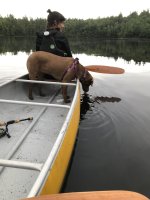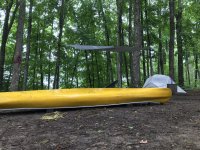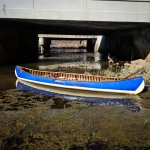 Hey everyone,
Hey everyone,first off, I’m new to this and basically any online thread. I’m most likely going to ask questions that a lot of you have seen or responded to multiple times. But I’ve already seen and read a lot of information or just fun paddling posts.
Last summer I picked up a 17’ fiberglass Hoefgen canoe. Hand built in 1985 in Menominee, MI. I’m the 3rd owner and found out that it was stored inside for almost its entire life then donated to a camp I went to when I was a kid. It’s actually in really good shape.
So far, I’ve removed the seats and have cleaned them up, sanded them down, re varnished and added new flat webbing to them. The webbing may be swapped out for rope, I don’t like the old holes exposed between the webbing.
What I want to do:
call me crazy but I want to sand the paint off or down and repaint it a different color. I was thinking white or maybe a good deep blue. any suggestions about quality paint and a clear coat? More eco friendly the better, but I get that’s not likely. The yellow paint right now looks ok, and is in relatively good shape. It does however leave yellow streaks when I hit bottom or pull it onto shore. Trust me, I know better than to drag a boat besides up onto shore.
my other goal is to remove the aluminum gunwales and replace them with some ash or cherry wood. They’re riveted on currently, so I’m not sure if that’s going to be more headache than it should be. While doing this, replace the decks with wooden versions as well.
During this Stay at home order, I have time on my hands and figured this would be a good project to do. Between house projects.
so any suggestions, thoughts, input anybody is willing to discuss, I’m open. I appreciate it, highly. And I’m looking forward to all of the old and new discussions on here.





